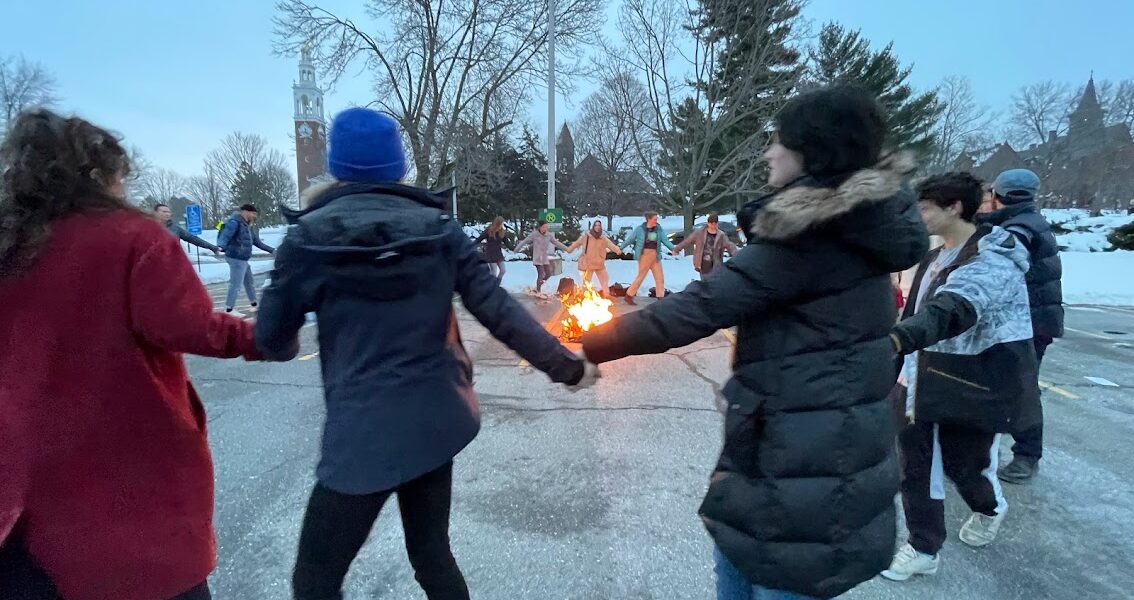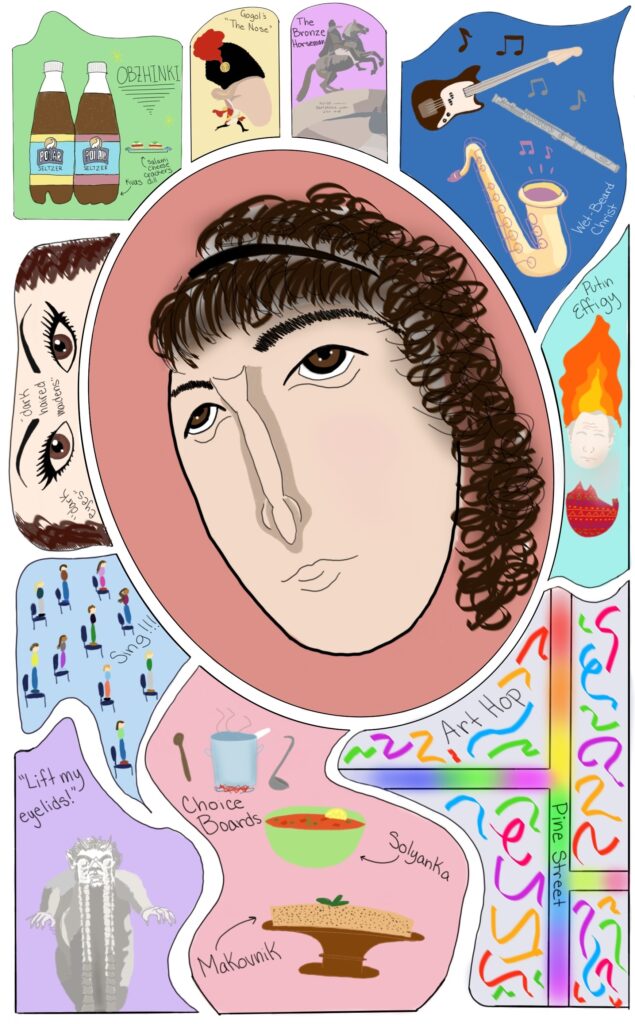In Praise of Old Tech: Digital Detox for the Classroom
By Kathleen Scollins and Devin McFadden, University of Vermont


DOI: https://www.doi.org/10.69732/MXJR7871
Introduction
Three years into pandemic-age teaching, most of us have become quite comfortable with — even enthusiastic about — the tech tools and techniques that enabled us to move our language and culture classes into the digital age. But last fall, the first true “back to normal” semester at my university, my ability to pivot back to a pre-pandemic norm was put to the test during an internet outage.
I was teaching a new first-year seminar examining the cultural roots of the Russian imperial project. Around a month into the semester, I arrived early to class, excited for my students to tackle the wrap-up activity I’d planned for our unit on nationalism: a sequence of tasks designed to draw attention to the common threads running through several centuries of nationalist thought. Due to nearby construction, however, our building was part of a service interruption expected to last several hours. My immediate, fleeting thought was to cancel class: every single step of my lesson depended on technology, from Google slides to group Kahoot, culminating with a shared doc students would annotate in pairs. But when the panic passed, I improvised a new plan based on what I’ve come to think of as “old technology”: whatever we happened to have in the room (moveable desks and a chalkboard) or backpacks (class coursepacks, pencils, and a set of sticky notes). In small groups, students reviewed the texts & identified their own list of common themes, which they jotted on sticky notes and stuck to the board. Shifting our chairs into a semi-circle facing the board, we talked through their ideas, regrouping them by theme; to my surprise, the students had identified all the themes I had intended to highlight, plus a few I hadn’t thought of.
So far, the period more or less approximated my tech-enhanced lesson plan, and I was about to introduce the final step in my sequence (now by hand, rather than shared doc) when the discussion took an unexpected turn to address the discomfort students had felt reading the more contemporary nationalist philosophers; the possibility — and potential consequences — of “canceling” such extremist views; and, more broadly, the intellectual and ethical issues surrounding free speech in a time of culture wars at home and imperialist wars abroad. These were not topics I’d planned to address that day, if at all — but the network failure pushed me out of my own electronic comfort zone, which in turn allowed the class to engage with issues both more universal and more intimate. Sitting in our circle and meeting one another’s eyes (without our usual slides and screens for distraction or protection) opened us to a less comfortable place, transforming the classroom into a space of dangerous, radical, and spontaneous vulnerability.
But this is not an article about what to do when technology fails: most of us taught before the pandemic forced us online, and it turns out those old instincts kick in when the tech kicks out. Rather, the episode reminded me about some of the things my tightly-planned, tech-heavy lesson plans might be inadvertently excluding from the classroom. Three years ago, I was one of those instructors who had to be dragged into the digital landscape of 21st-century teaching, resistant to integrating even online discussion boards or digital penpals until the pandemic forced me to try them. But as I became more comfortable with the online platforms and products that enabled us to continue teaching through the pandemic and beyond, as well as the advantages they offer both instructor and students (slides to reuse or adapt from semester to semester; online message boards I can respond to more thoughtfully than in the classroom; Kahoot, Flip, Padlet, and other tools I now find indispensable), I became a digital convert (with enormous gratitude to the editors of The FLTMAG; see also Gacs, Goertler, & Spasova, 2020).
In the intervening years, though, my teaching grew to depend upon those very tools which, just three years earlier, had freed my classroom from its spatio-temporal constraints and opened so many new possibilities. As my outage adventure suggested, these same technologies might now be acting as their own constraint.
What is a Tech Tolerance Break?
Over the past two decades, the seemingly limitless availability of digital content, as well as the proliferation of personal devices in the classroom, have revolutionized education, empowering students to personalize their learning experience and enhancing interest, agency, and motivation. Some experts across the fields of health, psychology, and education have begun to caution that these undeniable benefits can come at a cost to learners and educators alike if misused. It has become the norm for students to use laptops in class, for example, enabling them to access readings and digital materials, take notes, and participate in online activities or collaborative projects. Studies have shown, though, that students in lecture settings who are limited to printed materials, pen, and paper consistently outperform those with access to digital tools (Wood et al., 2012). This might be due in part to the finding that students with internet-enabled devices spend significant periods of class time engaged in off-task activities (Ragan et al., 2014); their bad electronic habits affect the performance not only of the multitaskers themselves, but of those students sitting within their view (Sana, Weston, and Cepeda, 2013). In fact, even when students are doing what they’re supposed to on their devices, it’s not at all clear that it’s doing them much good: a recent meta-analysis demonstrates that reading digital texts leads to lower comprehension, whether due to the distraction-rich online environment or the tendency to interact with all digitized media in the same quick, scroll-and-skim style we’re accustomed to from social media (Delgado et al., 2018). Researchers have largely focused on large-enrollment lecture courses; it is likely that the smaller discussion- or performance-based classes typical of our field would differ in both the uses of technology and their impact on learning outcomes; nonetheless, it is worth heeding their cautionary recommendations, particularly as the presence of technology increases — both within our classrooms and in the tasks we assign.
Even more significant than diminished learning outcomes, though, are the potential impacts on our (and our students’) social and mental well-being. One great irony of our connected age, with faraway family and former classmates only a click away, has been the concomitant rise of social disconnect, a sense of isolation exacerbated by the pandemic, when our physical and digital worlds merged. In the classroom, as in other social and professional arenas, technology-driven gains in efficiency, productivity, and innovation are predicated upon an expectation of constant online engagement, leading to heightened levels of anxiety, information overload, and the potential for social withdrawal (Ayyagari, Grover, and Purvis, 2011). Researchers have found that the mere presence of a mobile device in a social setting will negatively affect one’s sense of connection to others, as well as the quality of their conversation; this finding has profound implications for the discussion-based class (Przybylski and Weinstein, 2013).
In short, despite technology’s enormous potential to improve productivity, organization, and equity in the classroom, if we do not critically appraise the ways in which we’re using (or overusing) it, the costs might outweigh the benefits. Outside of our teaching lives, there is plenty of research pointing to the importance of taking an occasional break from technology: in 2021 the Cleveland Clinic calculated that the average American spent nearly 12 hours a day connected to some device, and elaborated the cognitive, social, and psychological benefits of unplugging for a given period of time. But despite this growing body of scholarship, much of the literature on technology in the classroom is still aimed at how to use this or that app, how best to integrate it, and what it can do for us — and not so much on what it does to us, or how to assess whether we even need that particular app in the first place.
And so, for all the same reasons some people might try “dry January” (or, closer to home, the University of Vermont students’ annual T-break from marijuana (Fontana)), it might be worth trying an occasional digital detox, whether for an isolated activity or a full day:
- Foster community: I was astonished by the difference in depth and quality of discussion when we all made eye contact, without the distraction (or psychological protection) of a mediating screen;
- Mix it up: we all know how important it is to meet the needs of students with different learning preferences, and just as some tech solutions will suit some students’ needs, a low- or no-tech approach will appeal to others;
- Keep it fresh: don’t let your offline teaching skills grow rusty; incorporating tech breaks will help keep your pedagogical grab-bag fresh and flexible. And one thing we all learned from the pandemic is how a shake-up in format (even an initially unwelcome one) can freshen our perspective and spur new ideas;
- Bring balance: instead of coming up with a tech solution for every pedagogical dilemma, aim to strike a thoughtful balance between the physical and the digital;
- Aim for (Real) World Readiness: as teachers of language and culture, we are readying students to connect with others, in both their own community and the world beyond — as much as possible, the communicative tasks we design should resemble the real-world interpersonal encounters we hope they’ll experience in their adult lives, and many of these do not include mediation from technology.
For the past several semesters, my colleagues and I have aimed to build such tech tolerance breaks into our language and literature classes at the University of Vermont, using only the “old tech” available in our classrooms (and in our students’ backpacks). We don’t see this exercise as a step away from those digital tools we’ve worked so hard to master over the past several years; in fact, I often come away from these days with a fresh appreciation for the speed and efficiency technology has brought to our profession! Rather, we see this as one way to step back and gain perspective on our own use of teaching technologies; to determine whether our digital habits might be inadvertently inhibiting our efforts to nurture community, spontaneity, and critical thought in the classroom; and to restore some balance after a few years of digital immersion. The strategies I recommend in the next section are based on literature and culture classes; further down, my colleague Devin shares ideas that she developed for the language classroom. We believe these will easily adapt to fit other teaching contexts, as well — in fact, many could be turned around and used in an online environment!
Space-Based Strategies: Re-Visioning Physical Learning Spaces
I based my own classes’ tech breaks on principles developed by advocates of place-based pedagogy and other theorists of physical learning environments (see Doorley and Witthoft, 2012; Promise of Place). The issue of material space, and its complex relationship to learning, has always felt like an under-studied, under-theorized factor in pedagogical research, and the move to virtual (or hybrid) teaching, then back back into physical spaces on campus during the early pandemic brought it into sharper focus. The series of adaptations — from physical to virtual space, then into larger auditoriums, and finally back into “normal” classrooms (which now seemed so small and restrictive) — pushed me to reflect more consciously upon the built environments I teach in, and how to incorporate what had worked well in the online environment, while undoing some of what hadn’t worked. I committed to transforming the material space of the classroom in some way (if only for part of the class) at least once a week, in an effort to jar us out of the digital terrain we half-inhabit whenever we’re connected to a digital device, and bring us fully back into the physical environment we share with one another. The spatial strategies I employed fall into three broad categories: reflecting, rejuvenating, and expanding/escaping. While the specific activities listed here were designed for my own courses in Russian literature and culture, they will easily adapt to accommodate other course material.
Reflecting on the physical environment
Once I had committed to my space-based form of digital detox, I figured I should get some buy-in from my new students. In order to draw their attention to the spaces we inhabit — as well as the ways our bodies make sense of them, and they, in turn, shape us — I designed a series of activities called “Learning (in) Spaces.” For the first four weeks of the semester, students would choose a particular “space” (on campus or in the broader community, depending on the assignment), in which they spent 10-15 device-free minutes engaging in a series of tasks: Learning (in) Spaces 1: on campus. Although students initially grumbled about spending 15 minutes without their phones, the reflections they later posted to a communal bulletin board — focusing variously on their sensory impressions of the physical environment, insights into how (and for whom) the space had been constructed, or creative representations of the space — proved profoundly astute, thoughtful, and original. The mandate to sit still and experience a small corner of the world, unmediated by a filter, screen, or search engine, pushed all of us to reflect more critically upon our reliance on those digital tools, and the ways in which they might shield us from sensory, social, or even intrapersonal encounters. Even several months later, a number of students commented on how much these conscious reflections on spaces had influenced them, not only in this course, but in their lives as students and community members.
Rejuvenating the space of the classroom
Although the size and layout of our assigned classrooms typically lies beyond our control, I decided to transform that space in a palpable way at least once a week. This might be as simple as reconfiguring the seats, ideas and rationales for which I browsed online (see Poorvu Center for Teaching and Learning, 2021). Even such small changes in spatial arrangement — initially intended to balance out the digital binge my pedagogical life had taken — had an unexpected side effect: every disruption of physical space brought a commensurate disruption of classroom hierarchies, habits, and social dynamics. The following list represents the strategies I found most effective for refreshing the learning environment:
- Get moving! For a class I taught on the Soviet Experience, we started every Monday class with group calisthenics, using a song/routine that would be familiar to every citizen of the USSR: На зарядку становись! Students initially thought I was joking when I ordered them out of their seats, but the exercise turned out to be a surprise hit, and always warmed students up for participation on an otherwise slow day for discussion.
- Act it out! Depending on what I’m teaching, I turn the classroom into a stage, upon which students enact, embody, or perform the text. This is a helpful technique when students are stuck on a tricky point of interpretation or just need help visualizing what’s happening. For example, when I teach Pushkin’s The Bronze Horseman, a long poem about the founding and flooding of St. Petersburg, I have students act out the major confrontation scenes in class. I cast one student as Evgenii, another as Peter the Great/Horseman, and others as various elements (howling wind, raging Neva); as one student reads the scene aloud, others are encouraged to shout out stage directions to the actors. The exercise enables students to perceive the work’s shifting power dynamics and cyclical structure in a more nuanced way.
- Gamble (or tell fortunes, or duel, or dance)! Principles of embodied learning can illuminate literary texts, particularly those written in an “unrelatable” time or style. When I teach Pushkin’s “The Queen of Spades,” for example, I make sure my students understand the central card game by breaking them into groups and making them gamble (with photocopied 19th-c rubles); the hero’s actions (and his downfall) are more legible if students can put themselves in his shoes. Not every text will lend itself to such embodied practices, but I have found this to be particularly helpful in those older works that feel less immediately accessible to our 21st-century students.
- Hold a gallery walk! An oldie but a goodie: turn the classroom into a gallery, and host an exhibition (with or without refreshments). I do this whenever students have completed some sort of creative assignment, like designing a new book cover or Soviet poster; the informality and fluidity encourages students to loosen old habits, explore new connections, and find kindred creative spirits.
- Raise your voices! Even though my literature students typically don’t know any Russian, they are always excited to learn a little (either by ear or through transliteration). One group got so into singing “Kalinka” and other folk songs that they formed a motley band (with bass, sax, and flute) to accompany the rest of us. Revitalizing a space doesn’t have to be physical: light (or its absence), sound (or silence), and other sensory changes can be equally transformative.

- Rise up! During a unit on the culture of revolutionary Russia, I asked students to sing along with a proletarian anthem I played on YouTube, the chorus of which they had learned as homework. But when students’ eyes stayed glued to the lyrics on the screen, I turned off the video (leaving only the audio) and ordered them to stand on their chairs. Suddenly, the space of the classroom was acoustically transformed as we lifted our voices in song, gazing at one another from our elevated vantage. Later, students noted how exhilarating it had felt to engage in this sort of collective experience — one of them commented that she finally understood the power of ideological campaigns: it didn’t necessarily derive from the words, or their intellectual persuasiveness, but from the unconscious, almost animal pull toward some corporeal unity.
- Get down! Just as standing on our chairs shook up the space of the classroom in a manner both elevating & equalizing, sitting on the ground can provide a similarly unifying disruption. One day last fall, when a planned outdoor picnic was snowed out, we decided to just hold the event in our classroom — and since we had all been planning on sitting on the ground outside, everyone was dressed for the occasion. Once we were all sitting on our blanket in a circle, picnic-style, our discussion took productive and provocative turns — the rules governing classroom behavior felt looser than usual, and the new configuration subverted any hierarchy that normally existed.
- Floor-time! My students enjoyed the indoor picnic so much, we decided as a group to institute a weekly “floor-time Friday.” Students brought blankets to sit on — some even started showing up in pajamas — and we spread out on the ground (I always specified that floor-time was optional, but most students in this particular class chose to participate every week). I began making old-fashioned handouts for those days, and I noticed how much more we all look one another in the eyes when we don’t have digital screens in front of us (whether my own projected slides or students’ individual laptops). The informality of our transformed environment — approximating the best part of online-learning within the confines of the physical classroom — also made it easier for me to relinquish control over the lesson.


Expanding the classroom environment (or escaping it altogether)
Sometimes the classroom space just isn’t large (or airy or bright or flexible) enough to accommodate whatever it is we want to do. For some activities, consider using the spaces immediately surrounding your room or building as an extension of the classroom; even a brief “field trip” away from the familiar is enough to bring a fresh angle to the material. Once or twice every semester, I like to hold an entire class outside of the classroom — or even off campus. These are more work to plan, but the escape inevitably energizes discussion and builds a strong sense of community.
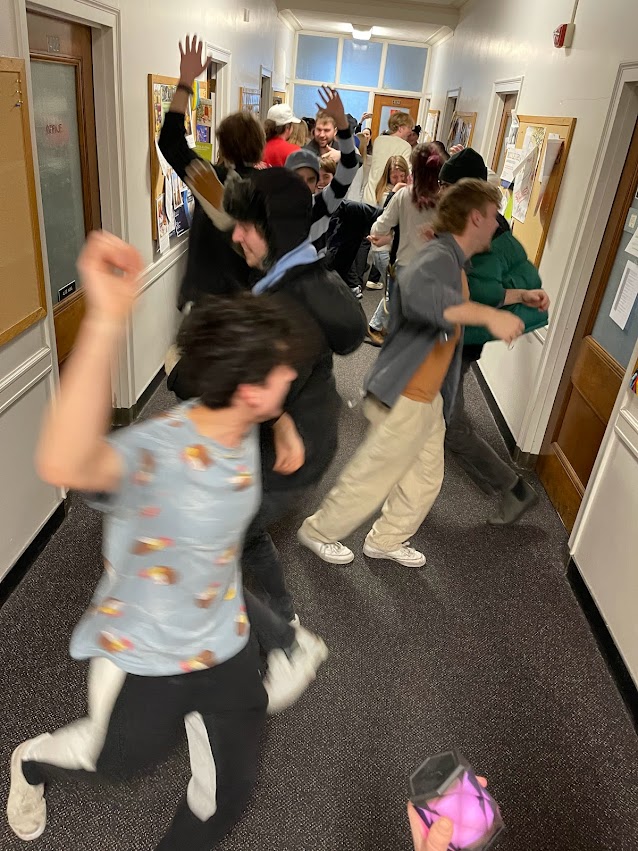
- Take it outside: sometimes poor classroom acoustics can impact focus or comprehension, particularly during pair or group work. Try offering students the choice of discussing in the hallway, rather than the classroom; the resulting “depopulation” turns down the volume, and students report that they appreciate the increased autonomy (as well as, presumably, the decreased cacophony). I’ve also noticed that the spatial separation also encourages greater diversity of analysis, as students are less likely to overhear and be influenced by the insights of other groups.
- Get a new perspective: several of the works we discussed last semester hinged on students’ understanding of Orthodox icons; since none of them had grown up in Eastern Christianity, though, the aesthetic principles were unfamiliar. In addition to the usual readings and lectures on iconography, I asked them to try it themselves: everyone had 20 minutes to represent a building or campus feature of their choice, using the principles of iconographic (“reverse”) perspective. When we all came back together to compare our experiences (and laugh at one another’s attempts), our discussion felt richer and more fully informed. Although this recommendation seems pretty niche, I plan to do it whenever visual art movements or aesthetics play a role in the works under discussion, from Constructivism to Socialist Realism; the more — and more diverse — paths to cultural understanding, the better!
|
|
|
- Involve the otherworldly: Every year around Halloween, I invite my students to summon a domovoi (Slavic household spirit), using a ritual I found online. Going outside — even just as far as the corridor or courtyard — offers spatial flexibility and contributes to the uncanny atmosphere; besides, communing with the spirit world really calls for a liminal space (a hallway, an alley — or, if possible, a nearby graveyard)! Variations on the theme: hold a ritual purification ceremony after a difficult module (as we did after concluding the nationalism unit with Putin’s 2021 article), or use a campus fountain for hydromancy.

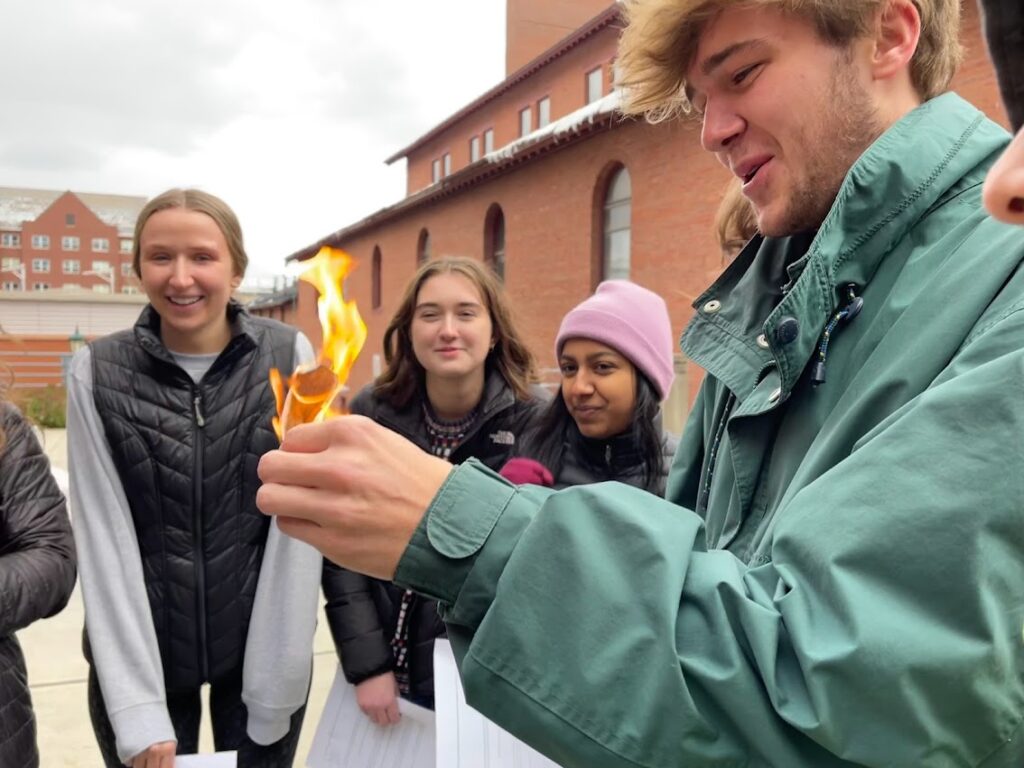
- When all else fails, burn something! As part of a unit on folk culture, I wanted my class to experience some of the rituals associated with Maslenitsa, the Slavic world’s annual equivalent of Carnival. It’s too cold in Vermont to hold class outside at that time of year, though, so we did the prep work inside (learning about the history and meaning of the ritual, practicing the circle dance) then headed to a parking lot just long enough for the actual burning of the effigy. [Note: we got permission from the campus fire marshal ahead of time; he passed on the dancing, but did try our Russian pancakes!]

- Put your students to work: A highlight of my Soviet Experience class was our Subbotnik (a communal day of community service), where we papered the campus with posters that students had designed, using visual principles of Constructivism, to advertise the following year’s introductory language classes. Students loved transforming these public spaces with their own art, and I saw a difference in enrollment the following fall!
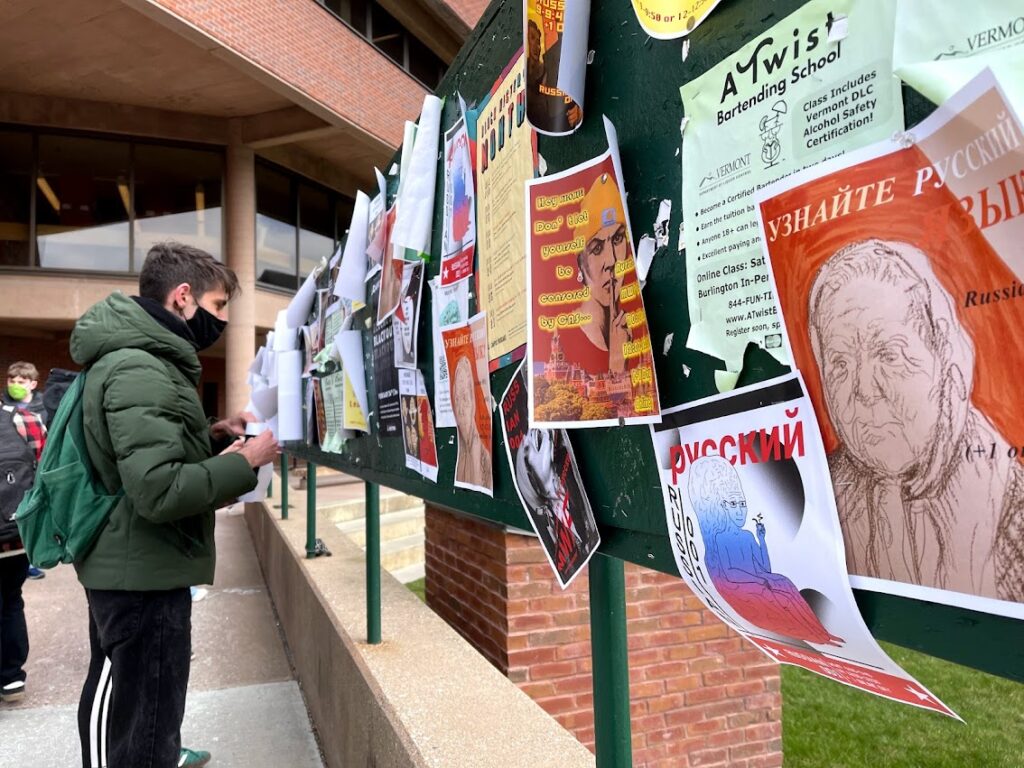
- Hold a site-specific poetry reading: Some works of literature demand to be read aloud, and I’ve found that some of the most powerful readings take place in an environment related to its themes: the Romantics feel more sublime in the wild, and urban poetry should be punctuated by car horns. A graveyard (conveniently situated just off campus) brought gravity to Akhmatova’s Requiem and made the climax of Gogol’s “Viy” extra spooky. Experiment with your own pairings of text and landscape, and bring the works to life outside the classroom!
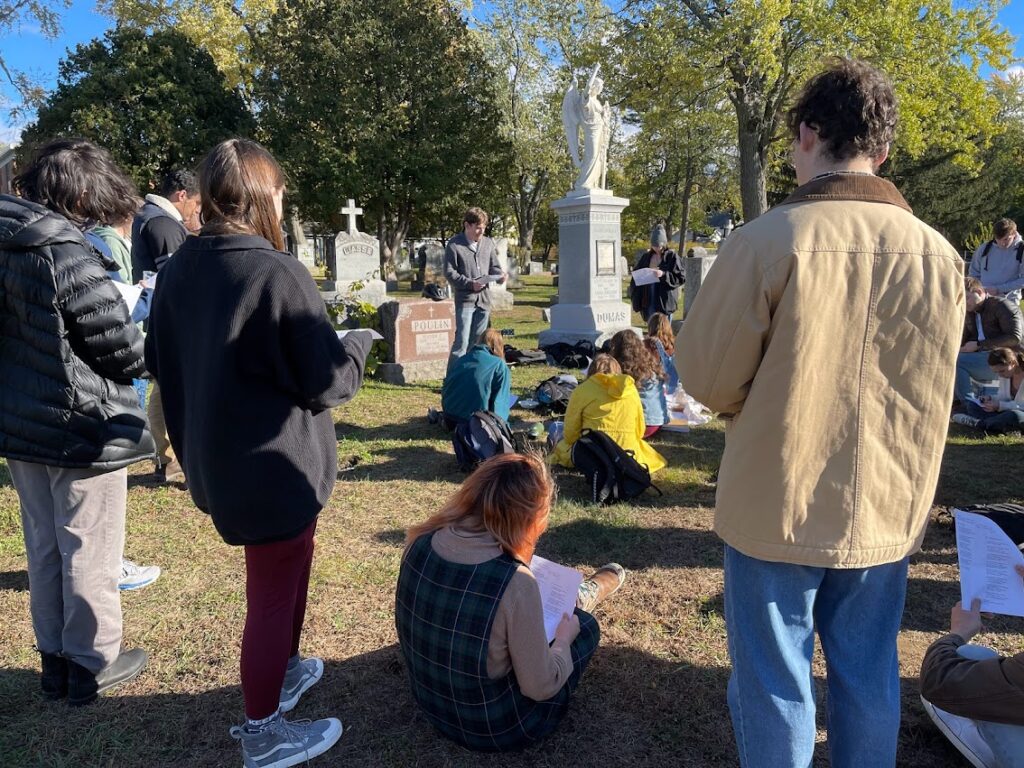
- Throw an underground party: In the waning years of the Soviet Union, subversive artists might perform at private kvartirniks, or apartment concerts, far from the ears (or censorious pens) of authorities. In courses on Soviet literature, I like to model my final class session on these clandestine meetings: I reserve a campus space ahead of time, which students may enter only by password, and we end the semester with an informal show of their own creative art (whether visual or performance-based).
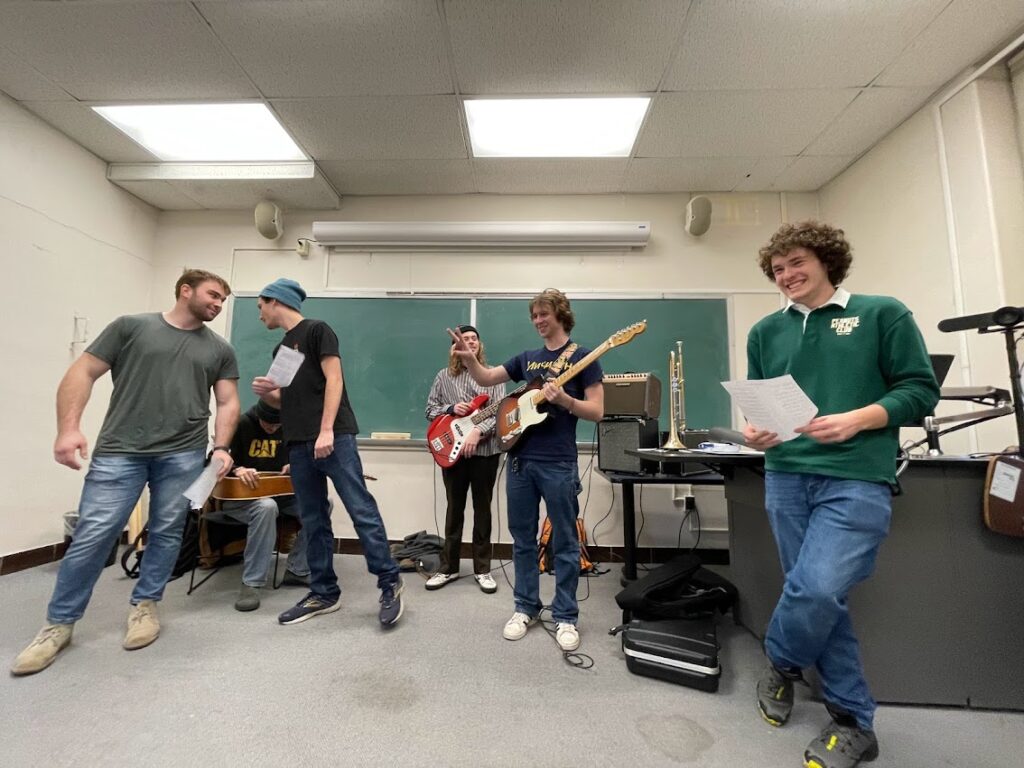
Inviting students to use or see our spaces of learning differently has helped all of us transition away from what occasionally felt like a uni-directional teaching model during the pandemic (make slides, send them out, hope students read them), and back toward a more collaborative, communal model of learning, where the learning environment is organically defined by social and intellectual interaction (rather than bricks and mortar). And while I was playing around with classroom configurations, my colleague Devin (whose ideas you’ll read in the next section) was taking another approach to digital detox, using nothing but office supplies.
Back to Basics: Use What You’ve Got!
One of my favorite activities from the first-year Russian textbook Kat and I use here at the University of Vermont, Mezhdu Nami, introduces the prepositional case using the question, “What is in [your] bookbag?” (Что [у вас] в рюкзаке?). I love this specific construction not because it’s easy for the students, but because it’s funny: unexpected and naïve, coupled with the fact that one student always has something interesting in their bookbag. My experience this past fall confirmed this supposition when one student shared that she had a Tamagotchi in her bag, who was due for feeding! The class burst into a rage of laughter — truly, it was hysterical! For the rest of the semester, this question became our most loved warm-up, matched with equal enthusiasm for the prepositional case.
Skip forward to a very cold, snowy Monday morning in February, and I could just detect the low energy among students by the slow, stomping wet boots on the Waterman staircase. In my lesson plan, I intended to teach dates and time using a PowerPoint presentation and online exercises. Though the activities relied on group work, I knew my lesson plan was not going to be memorable and decided to toss it aside at the last minute. Looking at my surroundings, I noticed all the flyers taped up in the hallway and had an idea: I’m going to teach my students dates by having them create their own flyers for imaginary events on campus and we’ll hang them up around the classroom and have our own “gallery.”
I rushed to print off 14 posters for events in the target language: photography and museum exhibits, poetry readings, makeup pop-ups, and concerts. I created a very simple handout of a chart broken into three columns, titled “type,” “date and time,” and “location.” The idea here being that they will use these charts to help delineate information from the flyers. I then grabbed a stack of large paper from the supply closet and a box of colored pencils I keep on hand in my office for my graphic novel course and headed to my classroom.
Our “warm-up” consisted of me showing them one of the 14 Russian posters. We dissected the event together in a similar fashion as they will be expected to do on the handout. After the warm-up, I assigned them partners and handed out the charts. I then went around the room and gave each group a Russian poster. Honestly, I didn’t even need to give them instructions as the assignment was so intuitive based on the warm-up, but I gave basic instructions in Russian, and they started working on their texts. As they finished each poster, I provided them with new ones. Each group worked through 3-4 posters. Next, I gave each group a piece of blank paper and opened the box of colored pencils and told them to create their own event at our university, including the information from the chart. I gave them roughly 20 minutes until they needed to “hang” their poster. As they were working, I walked around to each group and checked in with them on their ideas and for grammar support. Their events were incredible! One group depicted an electronic music rave at Nectar’s, a local bar in town, another showcased an Avant Garde fashion show, and an additional group were performing with Taylor Swift on Redstone campus on the last day of classes!
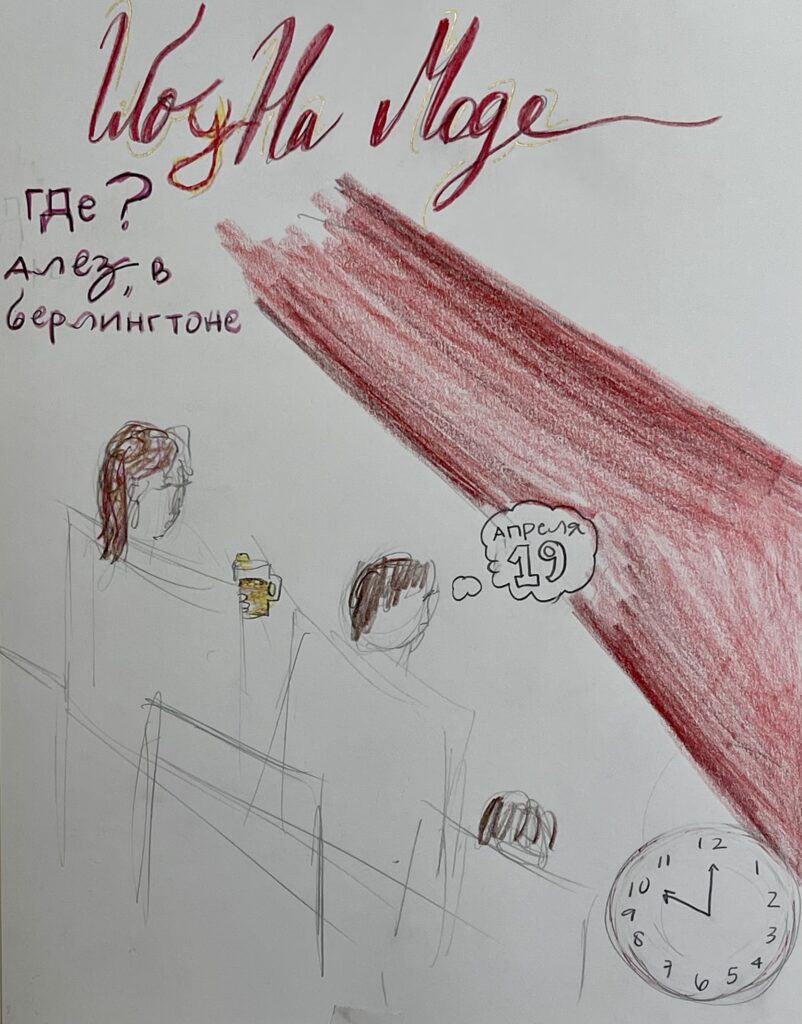
Once the posters were up, we spent 3-5 minutes walking around the classroom noting all the events and their dates and times in our last set of charts. In the final minutes of class, we walked around the classroom as a group and went over the events. My students were overjoyed with and energized by their “masterpieces”!
To this day, I have this class’s posters hanging on the walls in my office, which my students all love when they come to office hours! Many of them have shared with me in person or through evaluations that they loved this day and wanted more classes like it. When I reflect on this experience, I can’t help but think about how this “digital detox” not only refocused my students’ attention but also rejuvenated class spirit!
Conclusion
Three years ago, many of us were introduced to the creative and collaborative possibilities that technology can bring to our language and culture classrooms, enabling everything from virtual exchanges to gamified grammar. We are grateful for the vast array of digital tools (and community of supportive educators) that enabled us to face the special challenges of teaching languages in an online setting, and that have continued to diversify and animate our teaching since the return to “normal”; some of us, however, have become wary of our dependence on the very technologies that freed us from the strictures of the brick-and-mortar classroom. Now that our campuses have dropped pandemic protocols, we have an opportunity (and an obligation) to reassess our use of these tools: not only when to use which gadget in our expanded digital arsenal, but when it might be time to ditch them all in favor of some low- or no-tech alternatives. At the University of Vermont, our decision to return (at least periodically) to the “old technologies” of the classroom has had several positive outcomes, only some of which we anticipated:
- our experiments in place-based learning help build community, as students invest not only in the course material, but in the co-creation of a space in which we learn from one another;
- de-emphasizing the digital has the effect of reversing the pandemic-age trend toward an “information delivery” model of learning, in which students simply listen (often passively) to the content we deliver, reasserting the co-construction of knowledge through collaboration and engagement;
- periodically outlawing screens in class (the proliferation of which has been a slippery slope, now that so much of our course content has migrated online) reminds all of us how much they mediate — and sometimes even diminish — our interpersonal interactions.
Such measures aren’t an attempt to eliminate technology, but to gain some distance from it; our refreshed perspective will enable us to appreciate more fully both what it brings to our classes — and what it might be keeping out.
References
Ayyagari, R., Grover, V., & Purvis, R. (2011). Technostress: Technological Antecedents and Implications. MIS Quarterly, 35(4), 831–858. doi:10.2307/41409963
Cleveland Clinic healthessentials. (2021). 4 reasons to do a digital detox for less stress, more focus. https://health.clevelandclinic.org/digital-detox/
Delgado, P., Vargas, C., Ackerman, R., & Salmerón, L. (2018). Don’t throw away your printed books: A meta-analysis on the effects of reading media on reading comprehension. Educational Research Review, 25, 23-38. doi:10.1016/j.edurev.2018.09.003
Doorley, S., Witthoft, S. (2012). Make Space: How to Set the Stage for Creative Collaboration. United Kingdom: Wiley.
Editors of The FLTMAG. (2021). FLTMAG resources for COVID-19. The FLTMAG. https://fltmag.com/fltmag-resources-for-covid-19/
Fontana, T. (n.d.). T-break: Take a cannabis tolerance break. Center for Health & Wellbeing at The University of Vermont. https://www.uvm.edu/health/t-break-take-cannabis-tolerance-break
Gacs, A., Goertler, S., & Spasova, S. (2020). Planned online language education versus crisis-prompted online language teaching: Lessons for the future. Foreign Language Annals, 53(2), 380–392. doi:10.1111/flan.12460
Poorvu Center for Teaching and Learning. (2021). Classroom seating arrangements. Yale University. https://poorvucenter.yale.edu/ClassroomSeatingArrangements
Promise of Place. (n.d.). What is place-based education?. https://promiseofplace.org/
Przybylski, A. K. & Weinstein, N. (2013). Can you connect with me now? How the presence of mobile communication technology influences face-to-face conversation quality. Journal of Social and Personal Relationships, 30(3), 237–246. doi:10.1177/0265407512453827
Ragan, E. D., Jennings, S. R., Massey, S. R., & Doolittle, P. E. (2014). Unregulated use of laptops over time in large lecture classes. Computers & Education, 78, 78-86. doi:10.1016/j.compedu.2014.05.002
Sana, F., Weston, T., & Cepeda, N. J. (2013). Laptop multitasking hinders classroom learning for both users and nearby peers. Computers & Education, 62, 24-31. doi:10.1016/j.compedu.2012.10.003
Wood, E., Zivcakova, L., Gentile, P., Archer, K., De Pasquale, D., & Nosko, A. (2012). Examining the impact of off-task multi-tasking with technology on real-time classroom learning. Computers & Education, 58(1), 365-374. doi:10.1016/j.compedu.2011.08.029

